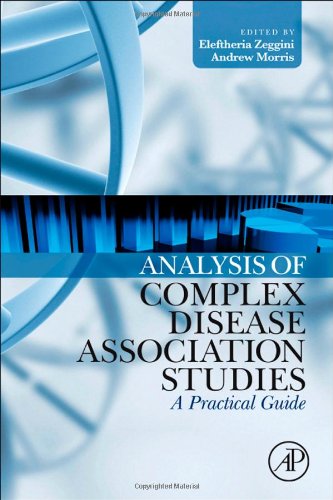طبق گفته مؤسسه ملی بهداشت، یک مطالعه ارتباط گسترده ژنوم به عنوان هر مطالعه ای در مورد تنوع ژنتیکی در کل ژنوم انسان تعریف می شود که برای شناسایی ارتباط ژنتیکی با ویژگی های قابل مشاهده (مانند فشار خون یا وزن)، یا طراحی شده است. وجود یا عدم وجود بیماری یا مورد. اطلاعات کل ژنوم، هنگامی که با سایر دادههای بالینی و فنوتیپی ترکیب میشوند، پتانسیل افزایش درک فرآیندهای بیولوژیکی اساسی را که بر سلامت انسان تأثیر میگذارند، بهبود پیشبینی بیماری و مراقبت از بیمار و در نهایت تحقق وعده پزشکی شخصیشده ارائه میدهد. علاوه بر این، پیشرفتهای سریع در درک الگوهای تنوع ژنتیکی انسان و بلوغ روشهای با کارایی بالا و مقرونبهصرفه برای ژنوتیپسازی، ابزارهای تحقیقاتی قدرتمندی را برای شناسایی انواع ژنتیکی که به سلامت و بیماری کمک میکنند، ارائه میکند.
این علم در حال رشد، اصول مطالعات آماری و ژنتیک را در هم می آمیزد تا حجم وسیعی از اطلاعات موجود از طریق نقشه برداری ژنوم را درک کند. به منظور استفاده حداکثری از اطلاعات موجود، ابزارهای آماری باید طراحی و به موضوعات تحلیلی اصلی مطالعات انجمنی در مقیاس بزرگ ترجمه شوند. تجزیه و تحلیل مطالعات ارتباط پیچیده بیماری دانش بیولوژیکی پیشرفته ای را در اختیار محققانی قرار می دهد که وارد حوزه مطالعات ارتباطی در سطح ژنوم می شوند و مبنایی برای استفاده مناسب و موثر از ابزارهای تجزیه و تحلیل آماری دارند. با استفاده از مثالهای ثابت در طول کار، فصلها بهترین شیوهها را برای شروع (طراحی) تجزیه و تحلیل و تفسیر دادهها با توجه به علایق پژوهشیشان در اختیار خوانندگان قرار میدهند. آزمونهای پرکاربرد برجسته میشوند و تجزیه و تحلیل انتقادی مزایا و معایب که با مطالعات موردی برای هر یک تکمیل میشود، اطلاعاتی را در اختیار خوانندگان قرار میدهد که برای تصمیمگیری درست برای تحقیق خود نیاز دارند. ابزارهای اضافی، از جمله پیوند به ابزارهای تجزیه و تحلیل، آموزش ها و مراجع، به صورت آنلاین در دسترس خواهند بود تا اطمینان حاصل شود که به روزترین اطلاعات در دسترس است.
- دسترسی آسان به اطلاعات پایه از جمله مزایا و معایب آزمون ها به ویژه. برنامهها، تعریف پایگاههای داده، زبانها و قابلیتهای آنها، ریسکهای مدیریت داده، آزمونهای متداول
- لیست مرجع گسترده شامل پیوند به وبسایتهای آموزشی
- مطالعات موردی، نکات و ترفندها
- /ul>
According to the National Institute of Health, a genome-wide association study is defined as any study of genetic variation across the entire human genome that is designed to identify genetic associations with observable traits (such as blood pressure or weight), or the presence or absence of a disease or condition. Whole genome information, when combined with clinical and other phenotype data, offers the potential for increased understanding of basic biological processes affecting human health, improvement in the prediction of disease and patient care, and ultimately the realization of the promise of personalized medicine. In addition, rapid advances in understanding the patterns of human genetic variation and maturing high-throughput, cost-effective methods for genotyping are providing powerful research tools for identifying genetic variants that contribute to health and disease.
This burgeoning science merges the principles of statistics and genetics studies to make sense of the vast amounts of information available with the mapping of genomes. In order to make the most of the information available, statistical tools must be tailored and translated for the analytical issues which are original to large-scale association studies. Analysis of Complex Disease Association Studies will provide researchers with advanced biological knowledge who are entering the field of genome-wide association studies with the groundwork to apply statistical analysis tools appropriately and effectively. With the use of consistent examples throughout the work, chapters will provide readers with best practice for getting started (design), analyzing, and interpreting data according to their research interests. Frequently used tests will be highlighted and a critical analysis of the advantages and disadvantage complimented by case studies for each will provide readers with the information they need to make the right choice for their research. Additional tools including links to analysis tools, tutorials, and references will be available electronically to ensure the latest information is available.
- Easy access to key information including advantages and disadvantage of tests for particular applications, identification of databases, languages and their capabilities, data management risks, frequently used tests
- Extensive list of references including links to tutorial websites
- Case studies and Tips and Tricks



